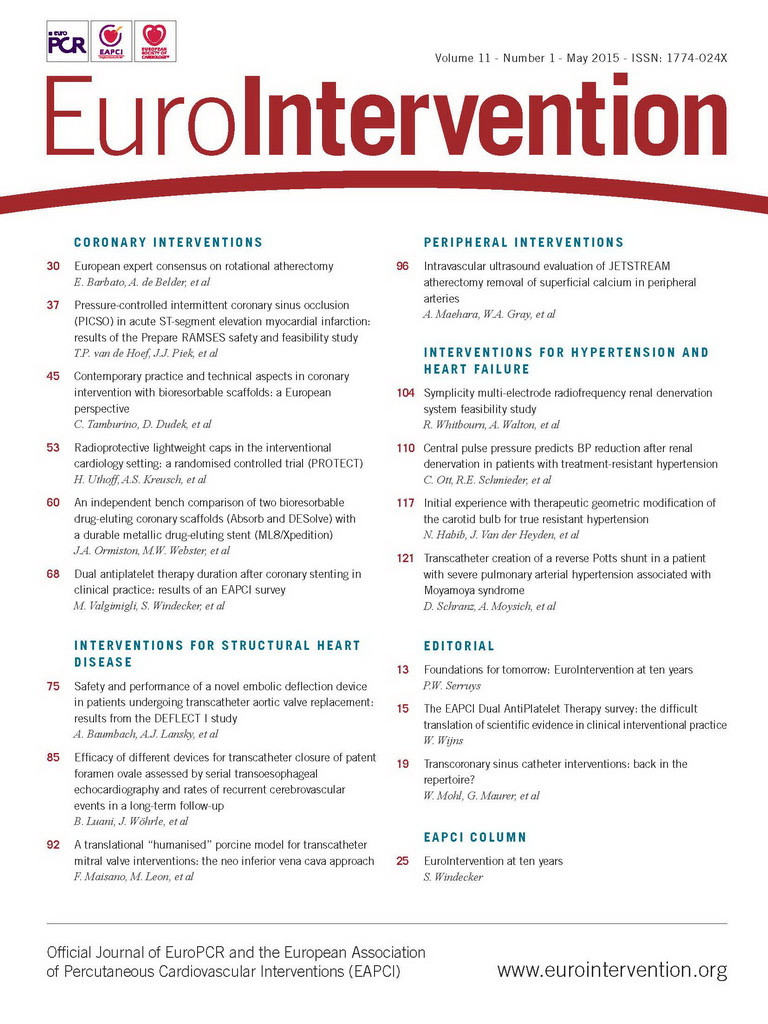
The report by Valgimigli and colleagues1 on the survey on dual antiplatelet therapy (DAPT) in interventional practice that was initiated by the Scientific Documents Committee of the European Association for Percutaneous Cardiovascular Interventions is seriously shaking the tree. Participants responded to a standardised questionnaire before the release of new, important trials at the 2014 American Heart Association sessions, and again after the meeting took place. The main conclusion of the survey was that the level of uncertainty was increased rather than resolved by the disclosure of new evidence. To quote the authors, “this EAPCI survey highlights considerable uncertainty within the medical community with regard to the optimal duration of DAPT after coronary stenting in light of recent reported trial results”.
These findings are challenging, but do not come as a total surprise. Each year at EuroPCR, the theme of the Great Debate covers a burning topic of the moment that has been identified directly by the PCR community. This year, “DAPT in everyday practice” showed up as the most frequently requested theme - by far. Finding the optimal synergy between device-based coronary interventions and adjunctive pharmacotherapy in each individual patient, especially with antiplatelet and anticoagulant drugs, has always been central to our practice. We are all aware that prior to antiplatelet therapy, using ticlopidine at the time, balloon angioplasty and early stent results were plagued with unacceptably high rates of early reocclusion and stent thrombosis. Today, we have so many options among which to choose: at least four major antiplatelet drugs (aspirin, clopidogrel, prasugrel and ticagrelor), numerous anticoagulants, and perhaps over 100 plausible antithrombotic combinations have been tested. Even the answer to a seemingly simple, everyday question remains elusive: after successful implantation of a drug-eluting stent in a low-risk patient, for how long do you recommend DAPT - 1, 3, 6, 9, 12 months, or longer!
No surprise that colleagues feel “uncertain” about best practice and are screaming out for guidance.
What is the value of such surveys?
The merit of previous, present and future surveys cannot be denied for several reasons:
– They allow us to shine a light on the issues at hand, uncover answers, stimulate discussion, help base decisions on objective information, and compare results and practices in different environments while providing a valuable snapshot in terms of attitudes and behaviours, and how they evolve.
– The outcomes of these surveys help us determine the need for new practice guidelines and recommendations by identifying the needs of the community. It is an excellent way for those of us working in these different scientific societies and guidelines committees to truly come to grips with the clinical reality in the field.
– Surveys allow us to advance in those areas where there is controversy. An example of this is the next survey that will be carried out called MATRIX (Minimising Adverse haemorrhagic events by TRansradial access site and systemic Implementation of angioX), which will be looking into the state of practice concerning the question of the radial vs. the femoral access.
In considering the values of surveys, let’s consider one by Toth et al2 who attempted to understand why fractional flow reserve guidance remains underused in spite of strong evidence and a class IA level of recommendation in the ESC-EACTS Revascularisation Guidelines. Interestingly, a major finding was that colleagues do not perceive the need for acquiring the FFR evaluation of functional stenosis severity. The available evidence on FFR was not challenged. Simply, when faced with typical angiograms, three out of four colleagues felt that adequate treatment decisions could be made without having – in addition to what they had already done – measured FFR. In other words, the available clinical and angiographic data were seen as sufficient and FFR as superfluous. It turned out that, based on available, but undisclosed FFR data, this perception led to inappropriate decisions in about half of the cases.
These examples clearly show that there is a need for tools such as this survey in order to understand physician behaviour, while monitoring the decision-making processes and practices in order to maintain, or perhaps establish, a stronger link between the drivers of evidence-based medicine and actual practice by the interventional community in the field.
Limitations of practice surveys
The EAPCI DAPT survey is web-based, and has its own inherent limitations. To begin with, it does not reflect the entire EAPCI community. On the contrary, as a web-based survey it has a very low cost, is extremely fast, and allows for a level of complex questioning that ensures better data. It should also be noted that the anonymity of respondents results in more honest answers to sensitive topics. The downside here is that changes in individual opinions, from prior to after the AHA sessions, could not be assessed.
Translating scientific evidence into clinical interventional practice
For anyone who is devoting her or his career as a clinical scientist to contributing small bits of incremental understanding to the body of knowledge, the findings of this survey, as well as other ones, are humbling. It is not surprising that one very popular session format at our different PCR courses is entitled, “Will this trial change my practice?” Certainly, the drivers of evidence-based medicine would not understand how such a provocative question could even be asked.
Earlier this year, at AsiaPCR, the question was asked, “Will the DAPT trial change my practice?”. The summary of this most interesting discussion will be published soon3. The practice of most panel members and co-authors of the summary article was to stop DAPT after one year. After the DAPT trial, they acknowledged that they now consider continuation of DAPT beyond one year on a case-by-case indication, depending on ischaemic and bleeding risk. Much to my surprise, in the audience most of our colleagues from the Asia-Pacific region routinely continue DAPT in patients at low bleeding risk, and did so long before the DAPT trial results were known!
This strategy is driven by risk aversion: if the patient did not bleed up to one year, the chances are low that it will happen at a later time. In any case, the physician does not want to take the risk of a late or very late stent thrombosis, especially after having recommended treatment interruption. To me, this was a revealing illustration of the “disconnect” that may arise between the “podium” and the “field”.
This observation tells us that we need to reflect on the clinical, practical relevance of evidence as generated by trials and clinical studies. At the moment, we can identify several areas in our daily work where a disconnection between practice and seemingly strong evidence is present: DAPT, mechanical thrombus aspiration during primary PCI for STEMI, radial versus femoral access, use of intra-aortic balloon pumping, etc.
Are the trials asking the clinically relevant questions? Are trial results addressing individual patient needs? Are patients we commonly see in our practice even enrolled in these trials? Are the trial endpoints also the relevant outcome metrics in daily life?
Blaming colleagues in the field for not applying Guidelines is not going to be helpful; it may even increase the gap and contribute to further degradation of the perceived value of “evidence”.
Let’s accept this challenge to seize an opportunity and reconnect the disconnected.
Conflict of interest
Institutional research grants to the Cardiovascular Center Aalst from Medtronic.

